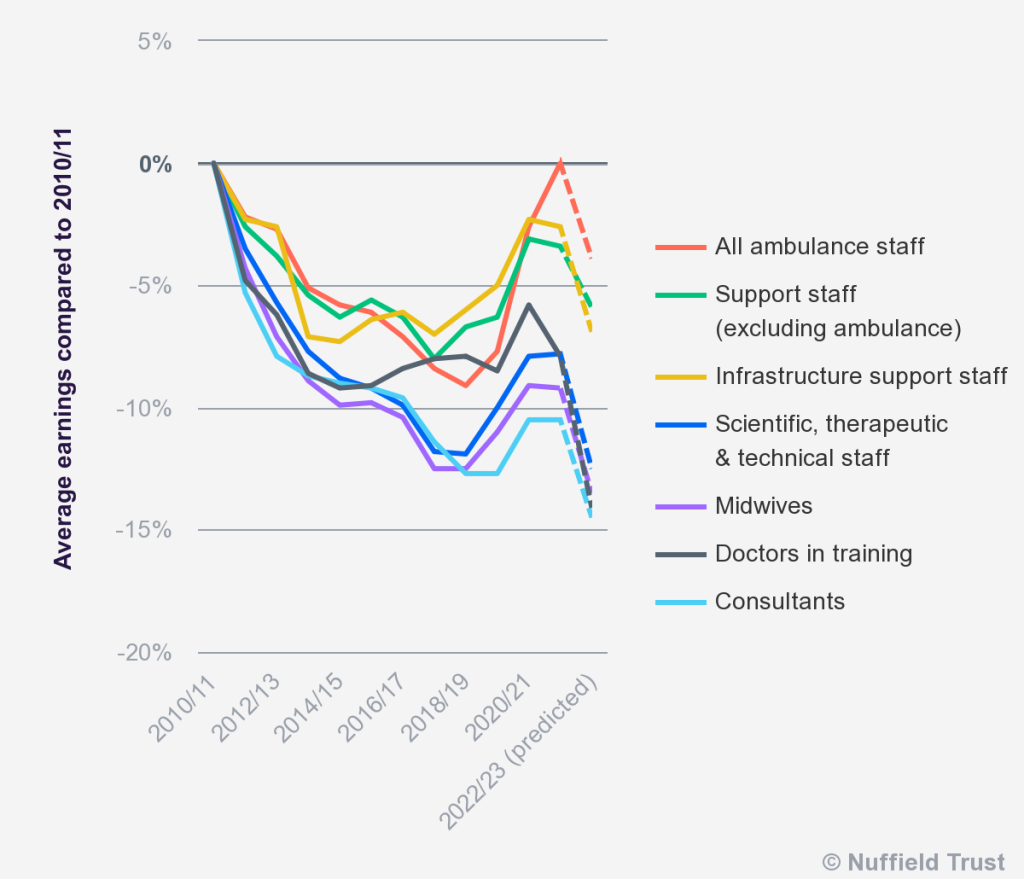Yesterday, the Chancellor of the Exchequer, Jeremy Hunt, presented the 2023 budget to Parliament. In this blog post, Lauren Bevan, our Director of Consulting, delves into the different aspects of the budget that are relevant to the NHS.
Up against it
If we consider comparing the NHS’s fortunes with a household budget, the NHS is broke. It can’t afford to fix the leaking roof, the food and energy bills are unaffordable, and that’s before we get to the reduction in buying power of the people who live there (in this strained analogy that’s the staff!).

Source: Chart of the week: Pay has fallen in real terms for most NHS staff groups since 2010
Ahem.
The now Chancellor, Jeremy Hunt has been aware of these challenges for some time as he was Health and Social Care Secretary for the 6 years of 2012-2018 which eagle eyed people might spot is the longest downward trajectory of this graph….
During this time, he committed to solving the issue of pensions tax which was contributing in a massive way to senior people leaving the NHS because in effect, they would be paying for the privilege of working additional sessions. The NHS does run on an immense amount of goodwill but was definitely a bridge too far.
So, what has been announced and where has there been absolute silence?
Workforce
The lifetime allowance has been abolished; this has been the main structural issue forcing NHS high earners out of the workforce. Until yesterday, any contributions over a lifetime allowance of £1,073,100 were subject to tax. Additionally, an extra £20k of pension contributions annually can be made tax free (£60,000 from £40,000) which provides both in year relief and benefit over a person’s career.
I hope that this will help with both recruitment and retention of senior talent within the service.
Also on a workforce perspective, the announcement of 15 hours a week of free childcare for children 9 months to 3 years when the current allowance kicks in is very welcome.
This will inevitably help some people to return to work, however, it may not be of much use to those who work 12-hour shifts (a lot of the NHS). Not an easy juggle.
It’s worth noting, that there has already been caution raised that the money to be given to providers may not be enough for them to run effective services so it’s a good promise which needs to be backed up with delivery and not crashing the market.
Tech
While this budget was notably tech-light, the Chancellor did announce £900m of investment into a national AI strategy. With the increasing availability of data, it will be interesting to see how much of this is used to harness the opportunities for NHS.
Mental health and musculoskeletal (MSK) health
The £310m assigned to mental health and MSK, again focussing on getting people back to the workforce, are welcomed but it’s hard to effectively triage people who could benefit from quick intervention and therefore return to the workforce. It isn’t the way the NHS has been used to prioritising so will require amended pathways as well as supporting technology.
But – no mention of new hospitals, pay rises, system investments, new treatments and frankly very little has been mentioned at a macro level.
In conclusion
This budget should help members of the workforce to feel they aren’t being penalised for working hard and long in the service but without any mention of pay rises or indeed the workforce plan demanded by Jeremy Hunt when he was a member of the Health Select Committee, whether it’s enough is yet to be seen.
NB – As an aside (and a reward for you getting this far in the article – through the course of researching this, I discovered that Jeremy Hunt’s second cousin is none other than Dame Agnes Hunt, the namesake of Robert Jones and Agnes Hunt Hospital in Shropshire. She was disabled, opened one of her own houses as a convalescent home for crippled children in 1900 and had a female life partner who she lived with for 30 years. I worked there and didn’t know that. So, there you go.
